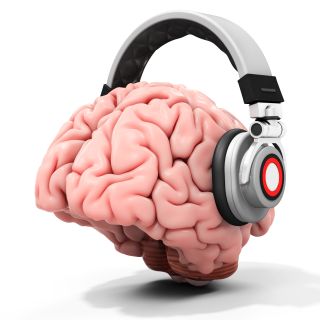Neuroscience
How Rhythm Gives Rise to Sensory-Motor Synchronization
The cerebellum and striatum synchronize musical beats with internalized rhythms.
Updated June 22, 2023 Reviewed by Michelle Quirk
Key points
- During rhythmic behavior, the brain creates internalized rhythms that sync to the beat if listening to music.
- New research identifies the brain networks involved in sensory-motor integration during rhythmic behaviors.
- Sensory-motor synchrony of internalized rhythms relies on information flows in cerebellum and basal ganglia.

While listening to music, our ability to feel internalized rhythms and generate rhythmic movements synchronized with a song's beat relies on the cerebellum and basal ganglia's striatum working in concert with other brain regions.
New research sheds light on how sensory and motor representations of internalized rhythms involve overlapping upstream and downstream flows of information in the cerebellum and basal ganglia. These findings (Kameda et al., 2023) were published on June 5 in the peer-reviewed journal PNAS.
The results of this study in monkeys suggest that during rhythm processing, the cerebellum is involved in multiple aspects of sensory prediction and rhythmically coordinated motor control, and the striatum plays a vital role in synchronized motor preparation.
In the paper's significance statement, Kameda et al. sum up the main takeaway of their findings: "[Our] results suggest that the flow of information from sensory prediction to motor preparation during rhythm processing is upstream in the cerebellum and downstream in the basal ganglia, although there is considerable overlap."
Personal Perspective: Experiencing Sensorimotor Synchronization While Running to Music
Since learning about Kameda et al.'s latest study a few days ago, I've been paying closer attention to how the actual beat of a song pounding in my earbuds synchronizes with sensory and motor representations of my own internalized rhythms while running on a treadmill.
For example, on an hour-long treadmill run this morning at dawn, I experienced 5 minutes and 39 seconds of sublime sensorimotor synchronization while running to Duran Duran's album version of "Ordinary World." Although the rhythmic beat of every song I heard during my sunrise run coordinated with my internalized rhythms to some degree, today, something about the BPMs of "Ordinary World" syncing up with my running tempo felt extraordinary.
With Kameda et al.'s paper, "Sensory and Motor Representations of Internalized Rhythms in the Cerebellum and Basal Ganglia," top of mind, the thing that stood out about running to "Ordinary World" this morning was the embodied cognition of feeling internalized rhythms synchronizing with my foot strikes even during sonic breaks in the song where there wasn't any percussion.
Notably, when the percussion-less lulls in the song ended and the drums kicked in again, my feet were striking the ground in perfect synchrony without missing a beat.
On its surface, "Ordinary World" feels like a slow and moody song with a metronome tempo of 70 BPM. While running and feeling the internalized beats, each foot clicked into a loping stride to the rhythm of 70 BPM, with every other foot strike synchronized with the actual drum beats. However, my wrists seemed to "pop" really quickly in between these strides at a double-time tempo of 140 BPM, which made the cadence feel like running to an uptempo bop.
During this short-lived superfluid flow state, I also experienced a synchronistic sense of my "self" and everything in the external environment melding. It's hard to describe, but for 5 minutes and 39 seconds, the sensory-motor integration I experienced created a frictionless connection between my inner and outer worlds.
The Neuroscience of Rhythmic Sensory-Motor Integration in Humans
Another recent study (Harry et al., 2023) on the brain networks involved in sensory-motor integration during rhythmic human behavior used fMRI neuroimaging to test people, not monkeys. These findings were published on March 15 in Neuropsychologia. Interestingly, first author Bronson Harry and colleagues identified distinct but overlapping cortical (auditory cortex and primary motor cortex) and subcortical brain networks (cerebellum and basal ganglia) that facilitate sensory-motor integration during rhythmic human behavior. Other research has shown that people with sensory processing disorder have altered cerebellar white matter, which is associated with impaired multisensory integration.
"Simultaneous self-other integration and segregation can be viewed as a specific form of balancing internal (self) versus external (other) sources of information. Expertise in domains where rhythm is a key element may be characterized by the strategic modulation of this balance," Harry et al. write. This description of "self-other integration" sums up what I experienced this morning while running to Duran Duran.
During rhythmic human behavior, the researchers identified an internal model of the "self" that plans the rhythmic timing of one's actions and synchronizes timing goals with motor commands using cerebro-cerebellar functional connectivity. The brain networks involved in this process include the cerebellum and a cortical circuit involving cerebral brain regions such as the premotor cortex, supplementary motor area, and inferior frontal gyrus.
As the authors explain, "Together, these feedforward and feedback loops optimize performance by adjusting the gain of own plans and other predictions by altering the connectivity within and between relevant cortical and cerebro-cerebellar circuits based on confidence, or probability estimates, that vary with task context (e.g., the systematicity of tempo changes) and cognitive load." (See "Cerebro-Cerebellar Circuits Remind Us: To Know Is Not Enough.")

Sensory-Motor Synchronization Can Make the "Ordinary World" Seem Extraordinary
The experience I had running to "Ordinary World" this morning felt profound. When the song ended, I straddled the treadmill for a few seconds and took a snapshot of the scene to help me deconstruct all the ingredients that made this particular episode of "rhythmic human behavior" feel so extraordinary.
What strikes me most about this photo now that I'm sitting still in front of a computer screen is how mundane it looks. My 24-hour gym is located in a strip mall. The "Anywhere, USA" view from the treadmills overlooks a CVS and an Applebee's. In reality, the scenery is bleak; it reminds me of the "paved paradise put up a parking lot" lyrics from Joni Mitchell's "Big Yellow Taxi."
Nevertheless, while I was immersed in the experience of watching the sun rise during an episode of sensory-integrated superfluidity running to "Ordinary World," the view out the window seemed paradisiacal. Based on the latest neuroscience, it seems to me that we can use rhythmic behavior like running to create sensory-motor synchronicity, and, in doing so, it's possible to transcend the ho-hum reality of daily life no matter where you are.
References
Masashi Kameda, Koichiro Niikawa, Akiko Uematsu, Masaki Tanaka. "Sensory and Motor Representations of Internalized Rhythms in the Cerebellum and Basal Ganglia." PNAS (First published: June 05, 2023) DOI: 10.1073/pnas.2221641120
Bronson B. Harry, Daniel S. Margulies, Marcel Falkiewicz, Peter E. Keller. "Brain Networks for Temporal Adaptation, Anticipation, and Sensory-Motor Integration in Rhythmic Human Behavior." Neuropsychologia (First published: March 15, 2023) DOI: 10.1016/j.neuropsychologia.2023.108524
Anisha Narayan, Mikaela A. Rowe, Eva M. Palacios, Jamie Wren-Jarvis, Ioanna Bourla, Molly Gerdes, Annie Brandes-Aitken, Shivani S. Desai, Elysa J. Marco, and Pratik Mukherjee. "Altered Cerebellar White Matter in Sensory Processing Dysfunction Is Associated With Impaired Multisensory Integration and Attention." Frontiers in Psychology (First published: February 03, 2021) DOI: 10.3389/fpsyg.2020.618436




